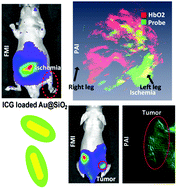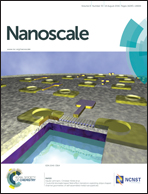Precise diagnosis in different scenarios using photoacoustic and fluorescence imaging with dual-modality nanoparticles†
Abstract
Photoacoustic imaging and fluorescence molecular imaging are emerging as important research tools for biomedical studies. Photoacoustic imaging offers both strong optical absorption contrast and high ultrasonic resolution, and fluorescence molecular imaging provides excellent superficial resolution, high sensitivity, high throughput, and the ability for real-time imaging. Therefore, combining the imaging information of both modalities can provide comprehensive in vivo physiological and pathological information. However, currently there are limited probes available that can realize both fluorescence and photoacoustic imaging, and advanced biomedical applications for applying this dual-modality imaging approach remain underexplored. In this study, we developed a dual-modality photoacoustic–fluorescence imaging nanoprobe, ICG-loaded Au@SiO2, which was uniquely designed, consisting of gold nanorod cores and indocyanine green with silica shell spacer layers to overcome fluorophore quenching. This nanoprobe was examined by both PAI and FMI for in vivo imaging on tumor and ischemia mouse models. Our results demonstrated that the nanoparticles can specifically accumulate at the tumor and ischemic areas and be detected by both imaging modalities. Moreover, this dual-modality imaging strategy exhibited superior advantages for a precise diagnosis in different scenarios. The new nanoprobe with the dual-modality imaging approach holds great potential for diagnosis and stage classification of tumor and ischemia related diseases.


 Please wait while we load your content...
Please wait while we load your content...